Whoopi Goldberg and breaking the movie star mold
- Oops!Something went wrong.Please try again later.
- Oops!Something went wrong.Please try again later.
- Oops!Something went wrong.Please try again later.
The Best Blacktresses: 1980s — The enduring brilliance of Whoopi Goldberg, nominated for Best Actress for 1985's "The Color Purple."
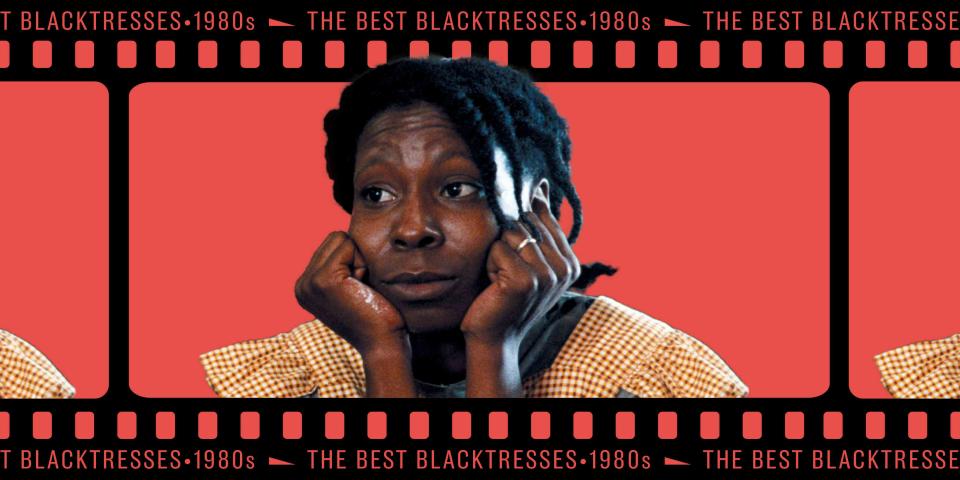
Everett Collection - Design: Alex Sandoval
Whoopi Goldberg in 'The Color Purple'The Best Blacktresses is a weekly, seven-part series dedicated to the 13 Black women and their 14 performances (shout-out to two-time nominee Viola Davis) nominated for Best Actress in a Leading Role in the Academy Awards’ nearly 100-year history.
The '70s felt like the start of something, if the three Black women nominated for Best Actress were any indication. They weren’t. Blaxploitation films went out of style. Motown, once a potential major player in Hollywood, was never able to recover from the failure of The Wiz — nor would its leading lady, Diana Ross.
The experimentation of the ‘70s, which produced some of the greatest films of the decade, gave way to another phenomenon, the blockbuster. And Black folks didn’t lead blockbuster films...yet. That changed with Eddie Murphy, a young upstart from Saturday Night Live, who, beginning in 1982, starred in a trio of films, each more successful than the last. Murphy became the biggest movie star of the decade, but he was mostly an action-comedy guy.
With 1988’s Coming to America, he made a bid as a romantic lead, casting relative unknown Shari Headley as his paramour. For a leading actress, there were two roles. Either she was a romantic interest or the heroine of her own story. As far as romantic interests go, Headley was among a small group of Black women playing that part in mainstream ‘80s American films. See also: Rae Dawn Chong.
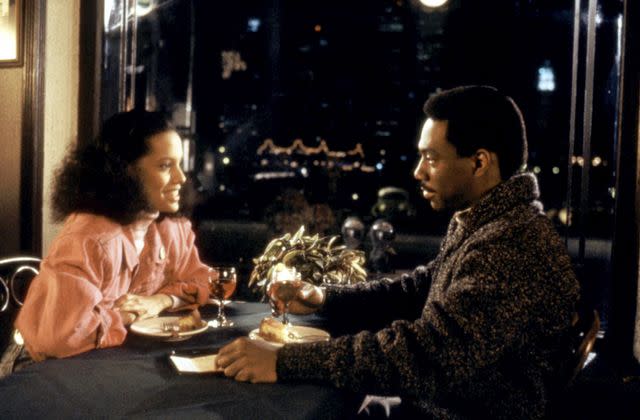
Hollywood has always shown little to no interest in telling stories about Black female heroes — the role of Black women’s contribution to history, particularly American history, having been systematically downplayed, obfuscated, or just plain erased.
In 1982, Alice Walker published The Color Purple and the following year it received the Pulitzer Prize for fiction, making Walker the first Black woman to win the honor. When Hollywood came a-callin’, Walker was resistant to sell the rights, citing the film industry’s problematic representation of women and African Americans. Walker only agreed to sell after meeting with a group of women who collectively decided that the only way to rectify the exploitative representation of minorities was to work within the system.
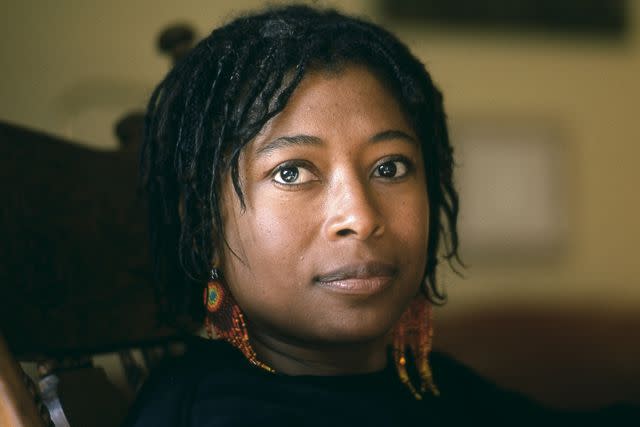
Caryn Elaine Johnson was born in Manhattan on Nov. 13, 1955. For a stage name, she took inspiration from the resemblance of her habitual flatulence to a popular gag gift, and what she claimed was her own Jewish heritage: Whoopi Goldberg.
Goldberg went on to train under the great acting teacher Uta Hagen and made her first film in 1982, the avant-garde Citizen: I'm Not Losing My Mind, I'm Giving It Away, featuring a number of other performance artists. Unable to find work as a young Black actress, Goldberg wrote a one-woman show so people “could see what I was capable of doing.” And she could do a lot.
Today, Goldberg is known as the kooky lady with the crazy shoes on The View, but her road there began with her prodigious talent as a performer.
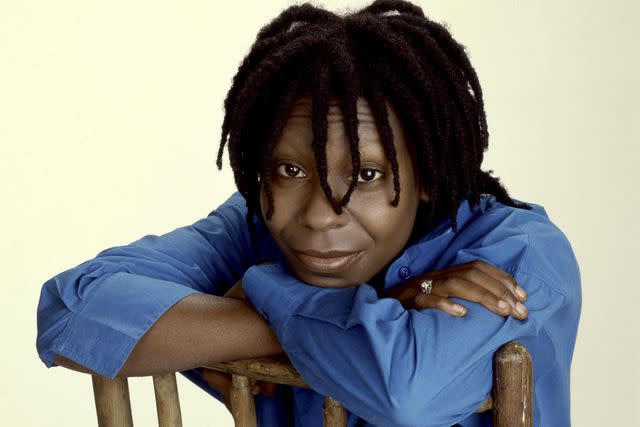
Bonnie Schiffman/Getty Images
Whoopi Goldberg, c. 1986Originally titled The Spook Show, it spotlighted five Goldberg characters who all go through their own personal evolutions on stage: a junkie on vacation in Amsterdam, a valley girl who gets pregnant and has a botched abortion, a Black girl who dreams of hair so blonde it will get her on The Love Boat, a Jamaican caregiver who inherits her elderly white patient’s fortune, and a disabled woman who falls in love.
The show attracted a lot of buzz and attention, including from director Mike Nichols, who helped Goldberg transfer the production to Broadway, retitled simply Whoopi Goldberg, with a run that lasted from 1984-1985.
The story goes that Goldberg was driving her daughter in the car one day when she heard Alice Walker doing a reading of The Color Purple on NPR. She pulled the car over so that she and her daughter could listen. Later, she wrote a letter to Walker saying that if they ever made a film of her novel, she “would like to play dust on the floor.”
Quincy Jones was a producer on the film version of The Color Purple and got Steven Spielberg on board, waiving his usual $15 million salary and taking only the Directors Guild minimum of $40,000. The director of Jaws and E.T. was a choice, but Spielberg loved the novel and did something he hadn’t done in a decade: pitched himself to Walker. And he won her over.
Meanwhile, little did she know, Goldberg’s name was already being tossed around for the lead role of Celie. Walker wrote back to the actress after receiving her letter, saying that she was well aware of Goldberg and her work, and had passed her name onto Spielberg. The director couldn’t make it out to New York to see Whoopi Goldberg, so Whoopi Goldberg came to L.A. to perform at the filmmaker's recently built theater at his Amblin Studios.
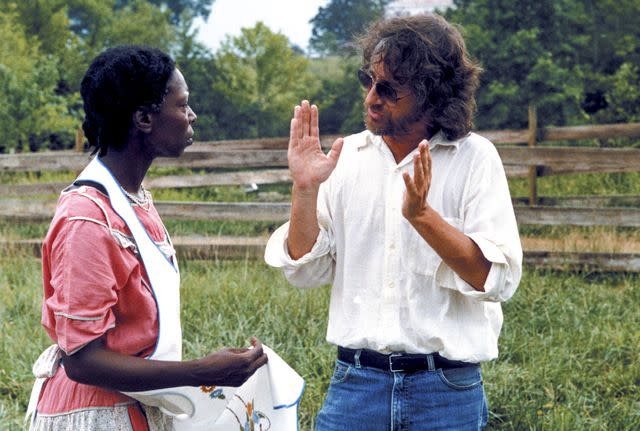
Everett Collection
Whoopi Goldberg and Steven Spielberg on the set of 'The Color Purple'Goldberg initially couldn’t believe that Spielberg actually wanted to see her. “I always knew I could act,” Goldberg said in 2014. “I just never thought I would be doing movies.”
When she got to L.A., Goldberg thought she would only be performing for Spielberg, but when she looked out into the audience, there was Quincy Jones and Michael Jackson...hangin' out...and waiting for her.
Goldberg performed her show as she usually did, but when her enraptured audience demanded more, she pulled out a character she had been told by friends and others not to do in front of Spielberg — BLE.T., a Black E.T. who lands in the projects of Oakland, gets stoned, and arrested for drug possession. Spielberg fell out of his seat laughing and Goldberg won the part.
Whoopi Goldberg’s filmography really doesn’t do much justice to her talent, with a few exceptions, The Color Purple perhaps chief among them. The Whoopi of The Color Purple is so unlike the Whoopi in the comedies she would become best known for in the late '80s and early '90s. Her Celie is deep and soulful, quiet but possessing an unspoken strength that shines in her eyes. Hers is arguably the most important film debut of the '80s, not only because of the power of her performance but also in the career she built after it.
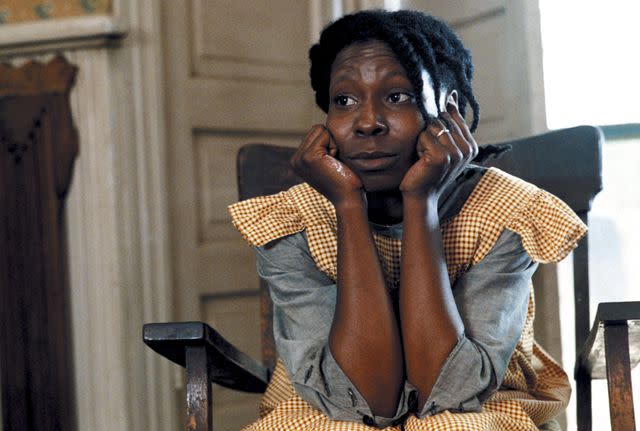
Everett Collection
Whoopi Goldberg in 'The Color Purple'When The Color Purple premiered in December 1985, it was met with a mixture of acclaim and controversy — acclaim for its performances, particularly Goldberg’s, and controversy over its depiction of Black men as violent abusers, as well as the choice of Spielberg as the director and his choice to soften the lesbian romance of the novel. That controversy has stayed with the original film, occasionally popping up in re-evaluations of it, but Goldberg’s performance has stood the test of time.
She won the Golden Globe for Best Actress in a Drama, as well as the Best Actress honor from the National Board of Review. Then she became the fifth Black woman nominated for Best Actress at the 1986 Oscars. The film was nominated for a total of 11 awards and, infamously, lost all of them. Was race a factor? Probably. Race is always a factor in America. And narratives about Black lives are rarely given proper recognition by the Academy — literally the first film predominately about the lives of Black people to win Best Picture was 12 Years a Slave in 2013, the 86th Oscars ceremony.
Notably, the only other film to lose as many nominations was 1977’s The Turning Point, a decidedly very white drama about two rival ballerinas starring Shirley MacLaine and Anne Bancroft. Still, the NAACP filed a protest against the Academy for snubbing The Color Purple, only months after the the organization had criticized the voting body for perpetuating stereotypes about Black men. So the movie was damned if it did, damned if it didn’t.
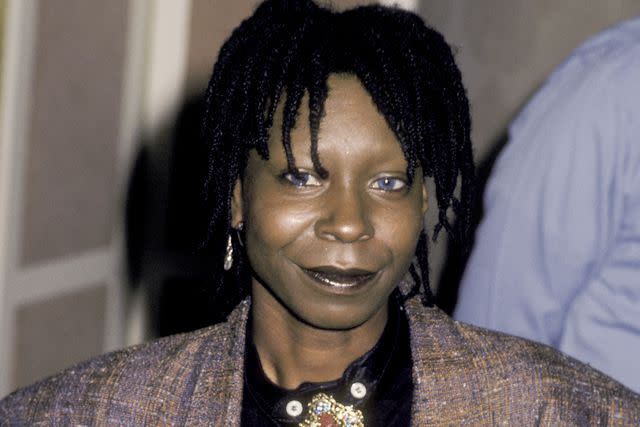
Ron Galella Collection via Getty Images
Whoopi Goldberg at the 58th Academy Awards nominees luncheonBut at least everyone could agree on Goldberg, with Roger Ebert predicting she would win for what he called "one of the most amazing debut performances in movie history." Goldberg lost the Best Actress Oscar to Geraldine Page for The Trip to Bountiful (for which Cicely Tyson would win her first and only Tony in 2013) in a stacked competition that included Anne Bancroft in Agnes of God, Jessica Lange in Sweet Dreams, and Meryl Streep in Out of Africa.
Goldberg would eventually win her Oscar, Best Supporting Actress for 1990’s Ghost, becoming the first Black actress to receive two Oscar nominations and only the second to win Best Supporting Actress, after Hattie McDaniel for Gone With the Wind. Of course, Goldberg would go on to become the first African American to EGOT, establishing a successful career outside of film. But for people who came of age in the ‘90s, Whoopi Goldberg was one of the biggest movie stars around.
Her ‘80s films after The Color Purple were mostly disappointments, failing to make proper use of her gifts. Her biggest hit in this period was Penny Marshall’s feature directorial debut Jumpin’ Jack Flash. But starting with Ghost, Goldberg hit a stride that catapulted her to stardom in a medium she initially had not even considered. Whoopi Goldberg didn’t look like a movie star, she didn’t act like a movie star, she didn’t have an origin story befitting a movie star, but her talent carried her through and she became a cultural force.
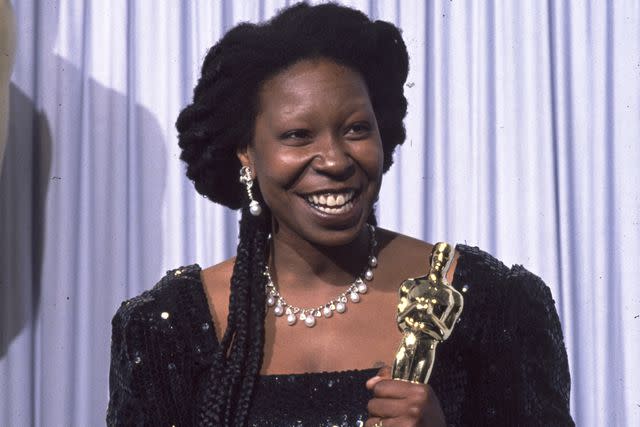
John Barr/Liaison
Whoopi Goldberg winning her Best Supporting Actress Oscar for 'Ghost'To wit, she was the inaugural and eventual three-time winner of the Kids’ Choice Award for Favorite Movie Actress. When kids can grow up seeing someone who breaks the mold of what they’re accustomed to, it affects their expectations as adults. Whoopi Goldberg showed what was possible.
In 1994, Goldberg hosted the Academy Awards for the first time, the first Black woman to do so, and went on to host the ceremony three more times. The last time she hosted, in 2002, Halley Berry won the award for which Goldberg had been nominated 16 years prior.
There was only one other actress between Goldberg and Berry to achieve the same recognition, despite the intervening years being filled with Black talent exploding onto movie screens. And we'll get into that next week.
Want more movie news? Sign up for Entertainment Weekly's free newsletter to get the latest trailers, celebrity interviews, film reviews, and more.
Related content:
Dorothy Dandridge and the burden of being first Black Best Actress Oscar nominee
Diana Ross, Cicely Tyson, Diahann Carroll, and kicking open the Oscars' front door
The Color Purple writer explains emotional reason for Whoopi Goldberg cameo
Read the original article on Entertainment Weekly.

